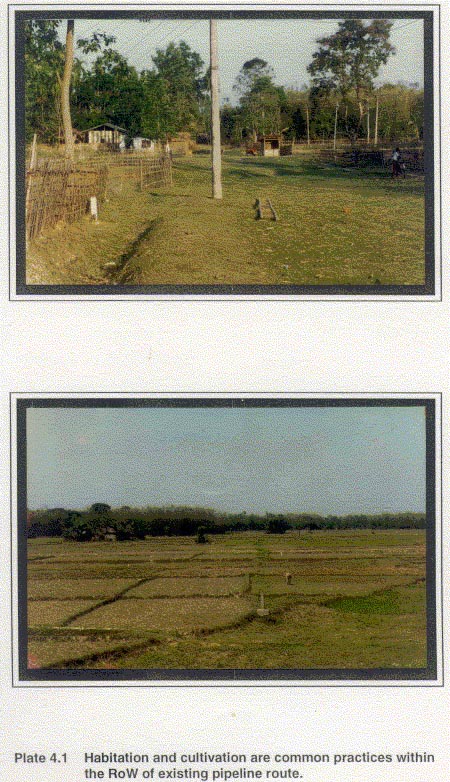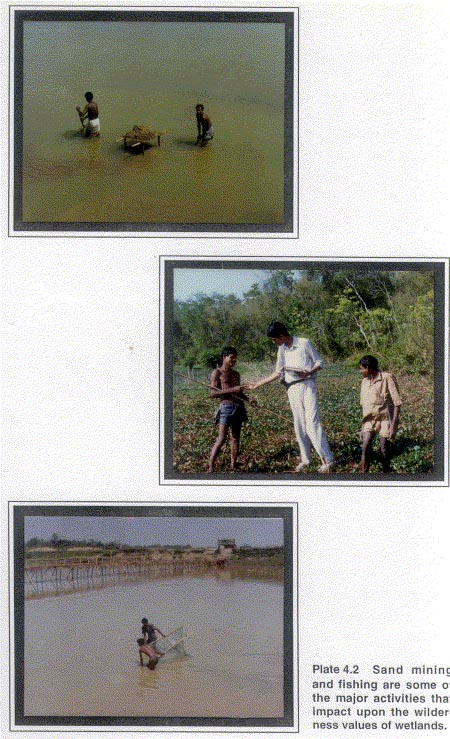Impact prediction
|
The success of an environmental impact assessment depends on the adequate identification of the potential impacts of the project on the environment. The prediction or identification of environmental impacts helps in determining the possible consequences of a given set of the proposed project activities on environmental elements. The activities and the environmental elements refer to the actions comprising the project and the physical, biological or human components of the ecosystem, affected, respectively (Julien et. al, 1991). The significance of impacts of the proposed project activities vary from habitat to habitat. As has already been indicated earlier in the section on baseline studies, nearly 42.5 km of the pipeline would be aligned within the existing RoW. No major impacts of the pipeline are anticipated in this area which is already being encroached by the local people for habitation and cultivation (Plate 4.1). The wetlands are the major habitats en route the pipeline that are likely to be impacted upon.
The following are some of the threats that can affect the wildlife values of the wetland habitats.
The proposed Jorhat-Numaligarh pipeline project is likely to have impacts on the wetland habitats en route the pipeline. As on today, no survey markings indicating the route were observed during field assessment, the route corridor identified by EIL on the toposheets has therefore formed the basis of this study. The assessments of likely impacts of the proposed pipeline on the floral and faunal values have been made based on the route indicated by the authorities of Environmental Division, EIL, New Delhi. The following parameters were taken into consideration for the determination of the severity of the impacts on these wetlands:
The impacts of the proposed project on the wetland habitats en route the pipeline have been discussed below under two separate heads viz: River Corridors and Beels. 4.1 River Corridors The proposed pipeline route would be traversing through two river corridors viz. Dhansiri and Kakadanga. The likely impacts of the proposed project activity on these two river corridors, under two different phases of the project viz: Construction phase and post construction phase, have been visualised and discussed here. Dhansiri River Corridor Fishing and sand mining activities are regularly carried out in this area by local fishermen and villagers (Plate 4.2). Instances of poaching of otters and sometimes of dolphins during monsoon and post monsoon season are frequent. The wildlife values of this wetland habitat are thus facing considerable level of biotic pressures even prior to the initiation of the proposed project. The impacts of the construction and post construction phases of the project would lead to further degradation of wildlife habitats and depletion of wildlife values.
Gangetic dolphin (Platanista gangetica) and otter (Lutra sp.), are important species from the conservation standpoint. The Gangetic dolphin (Platanista gangetica) is one of the two types of freshwater river dolphins found in the Indian sub-continent. In Indian waters, the gangetic dolphin is distributed in the Ganges and the Brahmaputra rivers. It has been declared an endangered species by the IUCN and have been included in the Red Data Book (Dey et. al, 1992). The river Brahmaputra with its large number of perennial tributaries provides a potential habitat for the gangetic dolphins. However, their distribution and abundance in these tributaries varies seasonally. In recent past, the population of this species has gone down drastically in the areas where they were in abundance. A survey conducted in 1992-1993 indicated that the total number of dolphins in Brahmaputra river was around 650 of which a small population of about 44 dolphins were found in the Dhansiri river, mainly near the confluence zone of Dhansiri and Brahmaputra rivers (Lal Mohan, et. al, 1992-1993). This species has been subjected to numerous threats due to construction of dams, siltation, gillnet fishing, depletion of fish stock, pollution and poaching. The Gangetic dolphin is mainly poached for its meat and oil. The otters are widely distributed throughout the Indian sub-continent (Prater, 1980). The information on otter population and its distribution is not available due to lack of any systematic survey. There are reports of otters in Brahmaputra river and its tributaries. This species of otter is an endangered species. Dialogue with local people revealed that the otter population in this area is regularly poached mainly for its skin, which is used for making caps out of it. The impacts of the proposed pipeline project have been visualized as follows:
Kakadanga River Corridor The baseline information on this river corridor reveals that this river corridor does not support any wildlife species of conservation significance. Moreover, there are no records of breeding population of any aquatic wildlife species in the nearby stretches of the river. For these reasons no major impacts of project on faunal values of river are anticipated. The only possible threat of the proposed pipeline to this wetland is from accidental leakage of petroleum products into the water. The probability of leakage would however, be quite rare as sophisticated leak detecting and monitoring devices would be installed by the project proponents. 4.2 Beels
The following are the impacts visualised on the beels located en route the proposed pipeline. Bar beel At present, the adjacent areas of the bar beel are inhabited. The people residing in this area use the beel water to meet their domestic requirements. Although, fishing is a regular activity, it is evident from the fish catches that the beel supports the fish fauna of a very small size. The following are the likely impacts of the proposed pipeline project on the bar beel.
Na beel The likely impacts of the proposed project that have been visualised for Na beel are almost similar to those predicted for Bar beel. |
Last Updated: October 8, 2015











